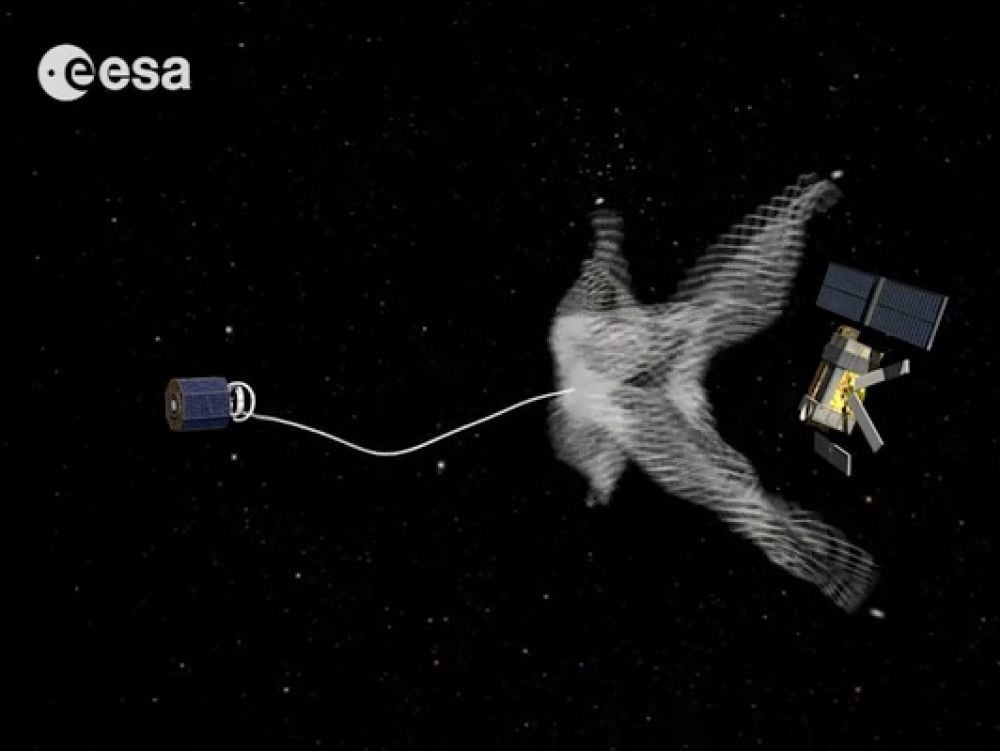Last summer, a new type of debris-hunting satellite was released from the International Space Station (ISS). It's known as the RemoveDebris spacecraft, a technology-demonstrator developed by Surrey Satellite Technology Ltd and the Surrey Space Center. The purpose of this satellite is to test whether satellites equipped with targeting software, a debris net and a harpoon are effective at combating space debris.
For the past few months, this spacecraft has been conducting a series of Active Debris Removal (ADR) exercises. About a week ago, according to a recent statement, the RemoveDebris satellite tested out its harpoon for the first time. As you can see from the video, the satellite successfully demonstrated its harpoon system and verified its ability to secure space debris and keep it from flying away.
The test took place on Friday, Feb. 8th, and consisted of the satellite's harpoon striking a target plate that was mounted on a boom 1.5 m (4.9 ft) away. The harpoon (which was developed by Airbus Defense and Space) was launched at a velocity of 20 meters per second (72 km/h; 45 mph) and speared the target while an attached cable kept the device from flying off into space.
As Guglielmo Aglietti, the director of the Surrey Space Center at the University of Surrey and the principal investigator for RemoveDebris, said in a University of Surrey press release:
This test was the third in a series designed to evaluate and validate the RemoveDebris' systems ability to deal with space junk. The first test took place back in September and consisted of the spacecraft deploying its net to capture a CubeSat. Designated DebrisSat 1, this CubeSat carried an onboard balloon that inflated to simulate a sizeable piece of orbital debris.
Chris Skidmore, the UK Minister of State for Universities, Science, Research and Innovation, also commended the success. "Space debris can have serious consequences for our communications systems if it smashes into satellites. This inspiring project shows that UK experts are coming up with answers for this potential problem using a harpoon, a tool people have used throughout history," he said.
The second test, which took place in October, validated the spacecraft's tracking and ranging lasers, its algorithms and its vision-based navigation technology. The test consisted of the spacecraft releasing a second CubeSat (DebrisSat 2) and then taking images of it and its surroundings using its flash LiDAR and color camera.
As Thomas Chabot, the Project Manager of the RemoveDebris' Vision Based Navigation (VBN) system at Airbus, said at the time:
The spacecraft measures roughly 1 meter (3 feet) on a side and weighs about 100 kg (220 lbs), making it the largest satellite deployed to the ISS to date. It contains experiments provided by multiple European aerospace companies and is one of several concepts that is currently being explored as a means of mitigating space debris.
According to the US Space Surveillance Network, there are more than 7,600 metric tons (8377.5 US tons) of space junk in and around Earth's orbit. Some of these objects reach speeds of up to 48,000 km/h (30,000 mph), which makes even micrometer-sized debris a serious hazard for orbiting missions and space stations. And it's only going to get worse.
In the coming years, thousands of satellites are expected to be launched in response to the growing demand for telecommunications services and worldwide broadband internet access. In addition, NASA and other space agencies are planning on mounting missions beyond LEO, which will mean more spent rocket stages and assorted components being jettisoned in orbit.
For this reason, some serious cleanup is needed to keep the skies above and the space lanes clear. Knowing that at least one of the proposed methods for doing this is effective is certainly encouraging.
*Further Reading: University of Surrey*
 Universe Today
Universe Today
